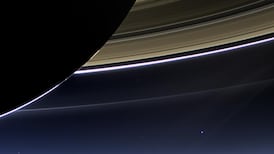The quartet of newly minted citizen astronauts comprising the SpaceX Inspiration4 mission safely splashed down in the Atlantic off Florida’s coast on Saturday, completing a three-day flight of the first all-civilian crew ever sent into Earth orbit.
“Welcome to the second space age,” Todd “Leif” Ericson, mission director for the Inspiration4 venture, told reporters on a conference call after the crew returned.
SpaceX, the private rocketry company founded by Tesla Inc electric automaker CEO Elon Musk, supplied the spacecraft, launched it, controlled its flight and handled the splashdown recovery operation.
The three-day mission ended as the SpaceX Crew Dragon capsule, dubbed Resilience, parachuted into calm seas around 11pm (7pm local time), shortly before sunset, following an automated re-entry descent, as shown during a live SpaceX webcast on its YouTube channel.
Within an hour the four smiling crew members were seen emerging one by one from the capsule’s side hatch after the vehicle, visibly scorched on its exterior, was hoisted from the ocean to the deck of a SpaceX recovery vessel.
Each of the four stood on the deck for a few moments in front of the capsule to wave and give thumbs-up before being escorted to a medical station on board for checkups at sea. Afterward they were flown by helicopter back to Cape Canaveral for reunions with loved ones.
Searing re-entry
The return from orbit followed a plunge through Earth’s atmosphere generating frictional heat that sent temperatures surrounding the outside of the capsule soaring to 1,900 degrees. The astronauts’ flight suits, fitted to special ventilation systems, were designed to keep them cool if the cabin heated up.
Applause was heard from the SpaceX flight control centre in suburban Los Angeles as the first parachutes were seen deploying, slowing the capsule’s descent to about 25km/h before splashdown, with another round of cheers as the craft hit the water.
The astronauts were cheered again as they stepped onto the deck of the recovery ship.
First out was Hayely Arceneaux (29), a physician assistant at St Jude Children’s Research Centre in Tennessee, a childhood bone cancer survivor herself who became the youngest person ever to reach Earth’s orbit on the Inspiration4 mission.
She was followed in rapid succession by geoscientist and former Nasa astronaut candidate Sian Proctor (51), aerospace data engineer and Air Force veteran Chris Sembroski (42), and finally the crew's billionaire benefactor and "mission commander" Jared Isaacman (38).
The Inspiration4 team blasted off on Wednesday from the Kennedy Space Centre in Cape Canaveral atop one of SpaceX’s two-stage reusable Falcon 9 rockets.
Highest orbit
Within three hours the crew capsule had reached a cruising orbital altitude of 585km, or just over 363 miles - higher than the International Space Station or Hubble Space Telescope, and the farthest any human has flown from Earth since Nasa’s Apollo moon program ended in 1972.
Two rival operators, Virgin Galactic Holdings Inc and Blue Origin, inaugurated their own space tourism services in recent months, with their respective founding executives, billionaires Richard Branson and Amazon.com founder Jeff Bezos, each going along for the ride.
Those suborbital flights, lasting a matter of minutes, were short hops compared with Inspiration4’s three days in orbit.
Mr Isaacman conceived of Inspiration4 primarily to raise awareness and donations for St Jude, one of his favourite causes, where Ms Arceneaux now works. Mr Ericson said the flight had so far raised $160 million for the cancer institute, including $100 million donated by Mr Isaacman at the outset.
Flying
The Inspiration4 crew had no part to play in flying the spacecraft, which was controlled by ground-based flight teams and onboard guidance systems, although Isaacman and Proctor are both licensed pilots.
But Ericson insisted the crew had “the same training and the same control and authority that Nasa astronauts have” to intervene in the Crew Dragon’s operation in the event of an emergency.
SpaceX’s human-spaceflight chief, Benji Reed, marvelled at how little went wrong during the flight, citing just two problems he described as minor and easily resolved – a malfunctioning fan in the crew’s toilet system and a faulty temperature sensor on one of the spacecraft’s engines.
The level of “space adaption syndrome” experienced by the crew – vertigo and motion sickness while acclimating to a microgravity environment – was “pretty much on target with what Nasa astronauts do,” Mr Ericson said.
All four had appeared relaxed and energetic during a number of live video appearances they made for Earth-bound audiences during their flight, from performing zero-G somersaults in the cabin to strumming a ukulele. – Reuters











